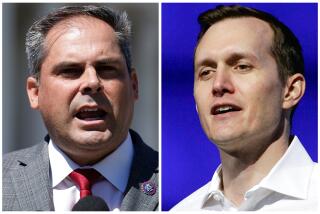Who Controls Congress May Turn on Few Races
- Share via
WASHINGTON — In sharp contrast to the lopsided presidential race, this fall’s battle for control of Congress is shaping up as one of the most closely fought in the last 40 years--a struggle that could turn on a handful of races that may defy prediction until election day.
Heading into the crucial final weeks of the campaign, Democrats are buoyed by President Clinton’s commanding lead in the polls, which suggest an electoral margin large enough to pull other Democratic candidates into office along with him.
But congressional Republicans, while increasingly worried about the party’s prospects, still enjoy a big edge in fund-raising and other advantages of incumbency. They pooh-pooh polls suggesting that more voters generally prefer Democratic candidates for Congress.
Both sides agree, however, that it will be a cliffhanger.
“The electorate is so fluid that everybody is skittish,” said Rep. Mark Edward Souder (R-Ind.). “The last two weeks are going to be more critical than usual.”
“It really will go down to the wire,” said Mark Mellman, a Democratic pollster. “There are so many races in play today on both the House and Senate side that it’s impossible to make a confident prediction.”
That is a big change. For 40 years, congressional elections were conducted against a backdrop of near certainty about the bottom-line outcome: Democratic control of the House and, usually, the Senate, was never really in question as hundreds of individual House and Senate races were conducted around the country.
Indeed, for much of the last generation, most congressional races were not even competitive--locked up either for the GOP or the Democrats. Even in 1994, it was not until the final weeks of the campaign that Democrats seriously seemed in danger of losing control of either the House or Senate.
Now, in the House, the Democrats need a net gain of 19 seats to win back control. In the Senate, they would need to pick up three more seats to create a 50-50 tie, enough to control the chamber if Democrats keep the White House because the vice president casts tie-breaking votes in the Senate.
Many nonpartisan analysts still give Republicans the edge in their fight to retain control of the Senate and the House. But the battle, especially in the House, is far closer than anyone predicted a year ago, when Republicans were at the top of their game. Since then, Republicans have been wounded by the collapse of their ambitious plans to balance the federal budget, by Clinton’s skill in co-opting key elements of their agenda and by the efforts of Democrats and organized labor to portray Republicans as extremists out to gut popular government programs.
Republicans began a comeback this summer when they moderated their rhetoric, passed welfare reform and a flurry of other bills that Clinton signed, and staged a national convention that boosted party morale.
But now, long after the post-convention spikes in popularity for both sides should have dissipated, Republicans are still looking at an ominous political landscape.
The latest Los Angeles Times Poll, conducted Sept. 7-10, indicates that voters generally prefer Democratic congressional candidates: Fifty percent of respondents who are registered voters said they would like to see a Democratic congressional candidate win in their district, compared to 40% who want a Republican. Democrats enjoyed an even wider edge among the crucial bloc of independent voters, who said, by a 51%-35% margin, that they prefer Democrats over Republicans.
Polling on party preferences in the congressional races has varied widely in recent months, but the best Republicans have been able to do in any recent published poll has been a statistical dead heat.
The Times Poll found that House Speaker Newt Gingrich (R-Ga.) is still a political liability with many voters. The poll found 34% of those responding were less likely to vote to reelect a House member if he or she voted with Gingrich most of the time; 11% said they were more likely to vote for that member.
But the figure that looms largest on the political battleground these days is the huge lead Clinton enjoys over GOP rival Bob Dole. The latest Times Poll found Clinton ahead, 51% to 35%. Presidential coattails are not as powerful as they once were, before ticket-splitting became common among voters. And Senate races tend to be less affected by presidential politics and other national political trends.
Still, a big victory for Clinton almost certainly would be a boost to Democratic House candidates, even though it remains unclear whether it would be enough to deliver control of Congress.
In presidential landslides, the winning party typically harvests a big crop of additional House seats. But in the two most recent landslides, the House gain was fewer than the 19 seats Democrats now need: Republicans picked up only 12 House seats with Richard Nixon’s victory in 1972 and 14 seats behind Ronald Reagan in 1984.
Some Republicans are trying to shrug off the potential effects of Dole’s difficulties by implicitly invoking the maxim of former House Speaker Thomas P. “Tip” O’Neill Jr. (D-Mass.), who coined the phrase: “All politics is local.”
“I’m a well-known commodity in my community,” said freshman Rep. Steve Chabot (R-Ohio). “I don’t think people are going to care very much one way or the other about national trends.”
“People are doing what they can to hold their seats,” Souder said. Some House Republicans are even beginning to calculate that their own political advantage may coincide with Clinton’s. They say the growing optimism in the national mood that has shown up in several recent polls will redound to the benefit of all incumbents, Republicans as well as Clinton. And the political fortunes of Clinton and congressional Republicans may be linked, many argue, because voters may want to keep Congress in the hands of Republicans to keep the Democrat’s liberal inclinations in check.
“Even if they do vote for Bill Clinton, people like checks and balances,” said Rep. Peter I. Blute (R-Mass.), who is favored to win in a district where Dole is running more than 30 percentage points behind Clinton. Blute has even taken to bragging about how much the GOP Congress has accomplished with Clinton’s support.
“We have some major accomplishments,” Blute said. “And we did it in a bipartisan way with President Clinton.”
Indeed, some Republican strategists say that in the closing weeks of the election, they will advise GOP House members to make that pitch explicit and argue to voters that if Dole is going to lose, they need to maintain a Republican Congress to keep watch over a Democratic White House.
But Democrats are trying to keep voters’ attention focused on the GOP initiatives Clinton opposed, particularly those that would have reined in the growth of spending in Medicare, student loans and other government programs. GOP efforts to present a more moderate image are “too little too late,” said Martin Frost, chairman of the Democratic Congressional Campaign Committee. “They are extremists not in line with the great majority of the American public.”
Some Republicans are concerned that House GOP candidates will suffer if Dole’s expected loss is so great that Republican voters simply don’t go to the polls on election day. That may be a particular problem in a state like California, where there are no senatorial or gubernatorial races to keep voter turnout high. The big question is whether these national political trends will, in individual races, outweigh the many basic advantages that Republicans have enjoyed throughout the campaign.
For one thing, the geography of this year’s political battleground gives Republicans a huge advantage: Democrats have to defend a large number of open seats in the South, where the GOP has been steadily gaining strength in recent years. What’s more, Democrats have not fielded their first-choice candidates in many districts, in part because candidate recruitment in many states, including California, took place last year when the party’s prospects still looked very grim.
“These are fundamental factors that will overshadow any effect of the presidential race,” said Rep. Bill Paxon of New York, head of the National Republican Congressional Committee.
Republicans also enjoy a big fund-raising advantage over Democrats. The NRCC raised $63 million by the middle of this year, more than three times the amount raised by its Democratic counterpart. But it’s not at all clear that money will be the decisive factor: It wasn’t in 1994, when Republicans won control of the House despite being outgunned financially.
James Campbell, a professor of political science at Louisiana State University who has studied congressional elections, said his research on past elections has convinced him that Democrats will win control of the House if Clinton wins with 53% of the vote or more.
“It’s going to be a very close contest for control of the House,” Campbell said. “All the indications are it’s a good year for Democrats.”
(BEGIN TEXT OF INFOBOX / INFOGRAPHIC)
House Races to Watch
REPUBLICANS
ARIZONA: J.D. Hayworth, a controversial freshman and former radio broadcaster, seeks reelection in a competitive district, and Democrats hope he may prove a bit too colorful for swing voters. His opponent, Democrat Steve Owens, is a former aide to Vice President Al Gore.
ILLINOIS: Michael Patrick Flanagan beat Dan Rostenkowski, then chairman of the House Ways and Means Committee, in 1994. Democrats believe that his victory was a fluke caused by Rostenkowski’s scandals and are determined to win back this heavily Democratic district in Chicago.
NORTH CAROLINA: Frederick K. Heineman won by a wafer-thin margin over Rep. David Price in 1994. The rematch of the two is a carefully watched barometer of the prospects for moderate Democrats to still win in the South.
TEXAS: Steve Stockman, a freshman who has at times seemed to offer support to radical militia organizations, is a key example of a Republican who Democrats hope is simply too conservative to prevail this year.
WASHINGTON: Rick White helped lead the GOP charge in a state that saw heavier Democratic losses in 1994 than any other. His race is a good indicator of whether the Democrats can regain their lost ground.
****
DEMOCRATS
ALABAMA: Bud Cramer will once again face Republican banker Wayne Parker in a race that tests the ability of Democrats to hold on to seats in the South.
GEORGIA: Cynthia McKinney is running for reelection for the first time since a court order struck down districts like hers that had been drawn expressly to be dominated by minorities. If she loses in her redrawn district, it could presage trouble for a number of other black Democrats in the South.
OREGON: Elizabeth Furse is a prime example of an incumbent who Republicans believe is too liberal to keep winning in a politically marginal district. She faces a rematch against Republican businessman Bill Witt, whom she narrowly defeated in 1994.
TENNESSEE: Bart Gordon, facing Nashville attorney Steve Gill for the second time, is a top GOP target.
UTAH: Bill Orton, a conservative Democrat, is a tempting target because he represents a district that is a Republican stronghold.
****
TOP RACES IN CALIFORNIA
Control of Congress could depend on which party wins control of California’s 52-member congressional delegation, the largest of any state. Currently, the state sends 26 Democrats and 26 Republicans to the House. The hottest races so far:
Eureka, Mendocino, Northern Coast (1st Dist.)
Democrat Michela Alioto, granddaughter of former San Francisco Mayor Joseph Alioto and a former Al Gore policy advisor, has money, a familiar family name and a compelling story of overcoming a physical disability. Two-termer Republican Frank Riggs has incumbency, but in the most fickle GOP district in the state. The seat has changed hands three times in the last three elections.
Northern Sacramento Valley, Davis (3rd Dist.)
Vic Fazio, the third-ranking Democrat in the House, each year grows more powerful in Washington and more vulnerable in his conservative rural Sacramento Valley district, where his party-registration edge has slipped another 3.5% since 1994. He outspent Republican Tim LeFever 8-1 in 1994, only to eke out a 4-percentage-point victory. LeFever is back, getting help from House Speaker Newt Gingrich and other GOP heavyweights; but Fazio is on pace to top the $2 million he raised in 1994.
Santa Barbara, San Luis Obispo (22nd Dist.)
In a rerun of 1994, conservative GOP incumbent Andrea Seastrand is up against the liberal Democrat Walter Capps, a college professor. She beat him last time by 1,563 votes. In one of the nation’s most closely watched congressional races, Democrats stress Seastrand’s signing of the GOP “contract with America”; Republicans hammer at Capps’ liberal positions on the death penalty and immigration. Voter registration leans GOP but shuns extremists of either party.
San Fernando Valley, Thousand Oaks
(24th Dist.)
Democrat Anthony C. Beilenson’s retirement has set up a race between two well-known, politically connected candidates in a dead-even swing district: Democrat Brad Sherman, a member of the State Board of Equalization, and Republican businessman Richard Sybert, who was defeated by Beilenson in 1994 by about 3,500 votes.
South Bay, Torrance, Palos Verdes
(36th Dist.)
Democratic incumbent Jane Harman kept her Palos Verdes Peninsula seat by an 812-vote victory in 1994, which was the closest race of the year, and challenger Susan Brooks is back to take another run.
San Bernardino (42nd Dist.)
Rep. George E. Brown Jr. is one of the last of his kind, an unapologetic progressive Democrat with 32 years in Congress. That posture, plus an increasingly conservative tilt to his blue-collar district, encouraged Republicans to list him among their top five targets nationally. Superior Court Judge Linda Wilde is a conservative jurist in a district where crime is a big voter concern.
North San Diego, Coronado, Imperial Beach
(49th Dist.)
This San Diego district leans Republican, but Democrats hope Clinton’s strength will spell trouble for GOP freshman Brian P. Bilbray. He faces challenger Peter Navarro, a UC Irvine economist with good name recognition after his unsuccessful race for San Diego mayor.
Three other seats held by Republicans could be in danger if 1996 turns into a strong Democratic year. In the 38th District, which centers on Long Beach, Rick Zbur, an openly gay environmental attorney, is challenging Rep. Steve Horn. In the 27th District, covering Pasadena, Glendale and Burbank, Democratic businessman Doug Kahn and Republican Assemblyman James E. Rogan are competing for the seat long held by Rep. Carlos J. Moorhead, who is retiring. And in the East Bay area, Democrats are hoping that Ellen Tauscher, one of the first women to hold a seat on the New York Stock Exchange, can defeat Rep. Bill Baker.
More to Read
Get the L.A. Times Politics newsletter
Deeply reported insights into legislation, politics and policy from Sacramento, Washington and beyond. In your inbox three times per week.
You may occasionally receive promotional content from the Los Angeles Times.










